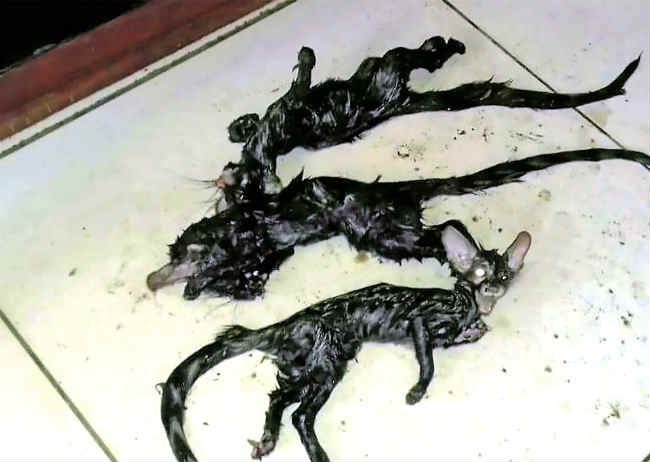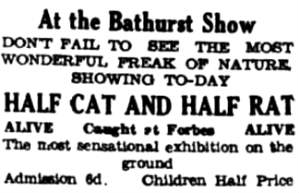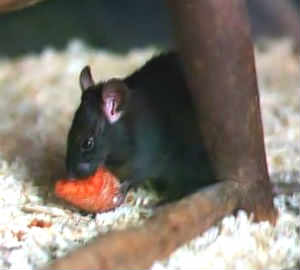Cat-rat Hybrids?
Mammalian Hybrids
 Three of the alleged cat-rat hybrids found in a house in Lethabong, Rustenburg, in northwestern South Africa in early 2017. As is often the case with strange hybrids, these animals were killed by individuals who were shocked at their appearance.
Three of the alleged cat-rat hybrids found in a house in Lethabong, Rustenburg, in northwestern South Africa in early 2017. As is often the case with strange hybrids, these animals were killed by individuals who were shocked at their appearance.
|
There have been abundance of Observations of Mixtures of Animals of more remote kinds such as between…a Cat and a Rat, of which, however improbable it may seem, there is an honourable Family that can produce abundance of Witnesses.
—James Drake
Anthropologia Nova (1727, vol. 1, p. 186) |
Claims that hybrids can be produced from this disparate cross would require further confirmation. In particular, it seems that none of the alleged specimens have been genetically tested.
John Locke (1632-1704), the English philosopher, is regarded as one of the most influential thinkers of the Enlightenment. Thomas Jefferson, for example, placed him on the highest rung of genius: “Bacon, Locke and Newton... I consider them as the three greatest men that have ever lived, without any exception” (letter to Richard Price Paris, Jan. 8, 1789). Through Jefferson, Locke’s ideas shaped the Declaration of Independence.
What are we to think then when an individual with such a forbidding intellect claims to have seen a cat-rat hybrid? In An Essay Concerning Human Understanding (III, Ch. 6, 23), Locke gives the following brief, but eyewitness, report:
If in making this claim Locke was correct, the sire in the cross would almost certainly have been a black rat (Rattus rattus), since at that time the brown rat (Rattus norvegicus) had not as yet reached Britain.
In the next century, the French naturalist Jacques-François Dicquemare (1733-1789) refers to what is probably the same case (Dicquemare 1778, p. 213):
 Ad about a sideshow supposedly featuring a cat-rat hybrid from the Bathurst, New South Wales, National Advocate (Apr. 26, 1933, p. 3, col. 7).
Ad about a sideshow supposedly featuring a cat-rat hybrid from the Bathurst, New South Wales, National Advocate (Apr. 26, 1933, p. 3, col. 7).
Is such a thing possible? The easy answer is “No.” But an honest one is that we simply know very little about the factors governing the ability of such disparate animals to hybridize. There is enough evidence that cats hybridize with rabbits that many people are convinced a cross between cat and rabbit can in fact occur, which is a rather similar cross to the one under consideration here.
Moreover, recent reports from South Africa allege the existence of numerous cat-rat hybrids found inside the wall of a family home in Rustenburg. Four of these creatures were killed, but two were captured and taken away alive by the local SPCA. Efforts are being made to obtain more information about this case.
So who knows? Perhaps a rat gamete and a cat gamete can on rare occasions combine and sort things out sufficiently to produce a viable organism. But any definite conclusions on this point will have to await firmer evidence. In the meantime, it can only be said that the evidence supporting this cross is meager indeed.
And then there’s the question of whether a rat is physically capable of covering a cat. Certainly, it’s true that rats and cats raised together get along well, and can even be snuggly friends, as can be seen in various YouTube videos.
Indeed, as surprising as it may seem, it’s known that tame cats will on occasion nurse baby rats (as shown in the video below), a significant fact in the present context; most mammals (and birds) imprint on the type of animal that raises them, that is, when they reach sexual maturity, they will choose to mate with that kind of animal even if that kind is not their own (read a discussion of imprinting elsewhere on this website).
Accounts of such behavior seem to be nothing unusual in the older literature. The following is one such case (from Bingley 1820, pp. 247-248):
Another case of a cat nursing rats >>
Indeed, a wide variety of animals will adopt those of other animals. Such is especially the case when the mother animal has recently lost her young. These bereft females, in whom maternal hormones are still coursing, have been known to seize upon the most unlikely foundlings. Speaking of one such case, Armen (1974, p. 53) comments that
In discussing the rearing of some greenfinch-siskin hybrids, bird breeder E. H. Bright (Bird Notes, 1916, p. 183) gives an example of this phenomenon in birds.
Another case, of a rather ambiguous nature, is described at the bottom of column 4 of the front page of the May 20, 1886, issue of the Democratic Northwest, a newspaper published in Napoleon, Ohio (source):
Perhaps this cat-suckled rat was merely adopted, as were the other young rats described above. However, it is at least conceivable that this cat actually did give birth to a rat. If so, this report would fall into the same category as certain other reports, quoted elsewhere on this site, in which one kind of animal supposedly gave birth to offspring of a different kind.
A list of cat crosses
The following is a list of reported cat crosses. Some of these crosses are much better documented than others (as indicated by the reliability arrow). Indeed, some might seem completely impossible. But all have been reported at least once. The links below are to separate articles. Additional crosses, not listed here, are covered on the cat hybrids page.
|
|
Most shared on Macroevolution.net:
Human Origins: Are we hybrids?
On the Origins of New Forms of Life
Mammalian Hybrids
Cat-rabbit Hybrids: Fact or fiction?
Famous Biologists
Dog-cow Hybrids
Georges Cuvier: A Biography
Prothero: A Rebuttal
Branches of Biology
Dog-fox Hybrids
 John Locke
John Locke Black Rat (Rattus rattus)
Black Rat (Rattus rattus)